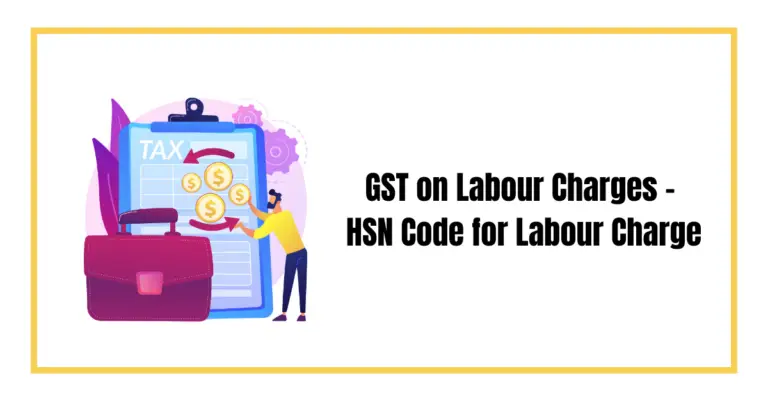The indirect tax process in India has become very simple and straightforward after the introduction of the Goods and Services Tax (GST) in 2017.
GSTR-7 is a crucial return filing form under the Goods and Services Tax (GST) regime in India. It is used for the deduction of Tax Deducted at Source (TDS) by the specified persons who are required to deduct TDS on payments made to registered suppliers. This form plays a significant role in ensuring compliance with the GST law and maintaining transparency in the tax system. In this comprehensive guide, we will explore various aspects of GSTR-7, including its importance, penalties for non-filing, the revision process, required details, features, and terms used in the form.
Anyone who pays tax must submit a tax return using Form GSTR 7 when making payments to suppliers for inward supplies received. GSTR-7 (Goods and Services Tax Returns) form must be filed by the 10th of the next month by a registered taxpayer subjected to deduct tax at source. This article details GSTR-7 return filing and covers all the important details, such as eligibility and filing requirements.
It is best suggested that you enlist the assistance of Vakilsearch for submitting the application, carrying out the necessary steps, filing your returns, and finishing other requirements on the portal.
Vakilsearch provides great services and must be preferred because of the following reasons::
- Online GST registration becomes simple, and you can easily obtain your GST Identification Number online
- Compliances are hassle-free since we take full charge of them
- Your returns will all be properly filed
- Our legal staff is here to answer any questions you may have and to walk you through the entire GST registration procedure.
Who can Deduct TDS under GST?
As per the GST law, certain specified persons are required to deduct TDS while making payments to registered suppliers. The following entities are responsible for TDS deduction:
- Government Departments: Any department or establishment of the Central or State Government, or local authority.
- Government Agencies: Any agency or authority established by the Central or State Government, with 51% or more ownership by the government.
- Local Authorities: Municipalities, Panchayats, or other bodies entrusted with the control or management of municipal or local funds.
What is GSTR-7?
The GSTR-7 is a type of GST return that is filed by both individuals and businesses filed monthly to deduct tax on customer purchases under the Goods and Services Tax (GST). A registered person deducting TDS under the GST must file Form GSTR-7 by the 10th day of the following month. Details such as TDS deductions, TDS payments, and TDS refunds are included in the form.
Input Tax Credit (ITC) for the TDS can be claimed by a person whose TDS is deducted. This credit can then be used to pay their output tax liability. After the deadline for filing GSTR 7, the deductee will get details of all the information regarding the TDS that was electronically collected in Form GSTR-2A. The deductee will receive the certificate for the TDS received in Form GSTR-7A and for the return filed in Form GSTR-7.
Why is GSTR-7 Important?
GSTR-7 is essential for both the deductors and the deductees as it serves the following purposes:
- Transparency and Compliance: GSTR-7 ensures transparency in TDS deduction and helps in the compliance of tax regulations by the deductors.
- Input Tax Credit (ITC) Matching: The details of TDS reported in GSTR-7 by the deductor are matched with the GSTR-1 and GSTR-2A of the deductee. This helps in a seamless ITC claim for the deductee.
- Tracking TDS Deductions: GSTR-7 allows the deductees to track the TDS deducted by the deductors against their GSTIN.
- Streamlining Tax Collection: TDS deduction under GST streamlines the tax collection process and helps prevent tax evasion.
Features of GSTR-7 Form
The GSTR-7 form comes with several features to facilitate easy and accurate filing
- Online Filing: GSTR-7 can be filed online on the GST portal, making it accessible to all registered deductors.
- Auto-Population of Data: Certain details in GSTR-7 are auto-populated based on data from GSTR-1 and GSTR-2A of the deductee.
- Summary of TDS Deducted: The form provides a summary of TDS deducted for the specified tax period.
- Verification: The GSTR-7 form includes a verification section that needs to be signed by the authorized signatory.
Terms Used in GSTR-7 Form
Deductor: The person or entity responsible for deducting TDS under GST.
Deductee: The supplier of goods or services from whom TDS is deducted.
TDS Certificate: The deductor issues a TDS certificate (Form GSTR-7A) to the deductee as proof of TDS deduction.
Interest on Late GST Payment & Missing GSTR Due Date Penalty
Apart from the penalty for late filing, if the TDS amount is not deposited with the government within the prescribed time, interest is levied at the rate of 18% per annum. This interest is calculated from the due date of deposit till the actual date of payment.
What is the Penalty for Non-Filing of GSTR-7?
Non-filing or delayed filing of GSTR-7 can attract penalties and interest charges. The penalty for late filing is Rs. 100 per day for each Act (CGST and SGST), subject to a maximum of Rs. 5,000. This penalty is applicable in the case of non-filing, as well as when there are discrepancies in the filed return that are not rectified within the due date.
How to Revise GSTR-7?
Currently, there is no provision for revising GSTR-7 once it has been filed. Therefore, it is crucial for deductors to ensure accuracy and correctness while filing the return to avoid penalties and compliance issues.
What are the Details Required in GSTR-7?
GSTR-7 contains various details related to TDS deduction, such as:
- GSTIN of the Deductor and Deductee: The GST Identification Numbers of both the deductor and the supplier to whom the payment is made.
- Invoice Details: The invoice numbers, dates, and corresponding taxable amounts on which TDS is deducted.
- TDS Amount: The amount of TDS deducted on each invoice.
- Challan Details: Information about the challan used for depositing the TDS amount with the government.
Who Must File Form GSTR-7?
According to the Central Goods and Services Tax (CGST) Act, Section 51, the following persons are entitled to deduct TDS. As a result, the following are subject to filing GSTR 7:
- Local authority
- Departments or organizations of the state or Central governments
- Agencies of the government
- Based on the Council’s recommendations, the Government might notify a certain group of individuals
- Board, authority, or entity created by parliament or state legislature, where 51% of the shares are with the government
- A society established by the municipal government, federal, or state government under the Societies Act of 1860.
What is the GSTR-7 due date?
For a given month, the GSTR-7 must be filed after the end of that month. The deadline for filing GSTR-7 is the the10th day of the next month.
For example, the GSTR-7 filing due date for October is November 10th.
How to File GSTR 7?
All the details regarding the taxpayers who want to deduct TDS from their GST returns are collected using the GSTR 7 format.
GSTIN: Upon registration, each registered taxpayer is given a unique GST Identification Number. Once the return is filed, the taxpayer’s Goods and Services Tax Identification Number (GSTIN) appears in GSTR-2A.
By partnering with Vakilsearch, you can obtain your GSTIN without any difficulties or delays.
Deductor’s Legal Name: This field appears automatically with the name of the registered person. By logging into the GST Portal, every registered person’s trade name can be auto-populated.
Trade Name: If available, the trade name of the Deductor.
TDS Details: GSTINs of all parties participating involved in the TDS transactions, along with all other relevant information (contact details, payment details, invoice-level data, dates, and TDS amounts), can be found here. The above-mentioned information can be used to calculate the GST to be paid for each of the three components (IGST, CGST, and SGST).
Changes in TDS information concerning the previous tax period: You can correct any errors in the information provided in previous months’ tax returns by putting the original and corrected information in this area. Because of this modification, Form GSTR-7A, the TDS certificate, will be updated.
TDS deducted and paid: The tax amount that has been deducted and the amount of tax that has been paid to the government are both shown in this section.
Late fee payable and paid and Interest paid: In case any late fees or interest applies to the TDS amount, the amount due for late fines and interest and the amount that has already been paid will be specified in this section.
Refunds claimed from the electronic cash ledger: In case of any refunds received for TDS payments from the electronic cash ledger, all the details will be shown here. The bank account to which the TDS refund has been credited is also given in this section.
Debit entries for TDS and interest payments in the electronic cash ledger: Once you finish filling the return and paying the TDS as well as any interest, if applicable, the entries in this section will automatically get filled in.
A declaration containing accurate information must be signed by the taxpayer after all necessary information has been given.
What Is the Penalty for Non-filling Out GSTR-7?
If the GST return filing is not filed on time, a penalty of ₹ 100 each under CGST and SGST, meaning to be a total of ₹ 200 per day, would be charged. The maximum penalty, however, cannot be more than ₹ 5,000. In case of a delayed filing, there is no late fee for IGST. Along with the late fees, interest must be paid at the rate of 18% per annum. It must be computed using the TDS that was paid. From the next day after the filing deadline to the payment date, interest will be calculated during that time.
Conclusion
GSTR-7 is a crucial return filing form under GST, requiring specified persons to deduct TDS while making payments to registered suppliers. It ensures transparency, compliance, and efficient tax collection in the GST regime. Timely and accurate filing of GSTR-7 is essential to avoid penalties and interest charges. By understanding the various details and features of GSTR-7, deductors can streamline the TDS deduction process and maintain compliance with the GST law. As the GST framework evolves, staying updated with the latest guidelines and provisions becomes vital for smooth tax operations for both deductors and deductees.
FAQs on GSTR-7 Return Filing
How do I file a return on GSTR-7?
To file a return on GSTR-7, follow these steps: Step 1: Log in to the GST portal using your credentials. Step 2: Navigate to the Services tab and select Returns > Returns Dashboard. Step 3: In the Returns Dashboard, select the financial year and the tax period for which you want to file GSTR-7. Step 4: Click on Prepare Online under GSTR-7. Step 5: Enter the required details, such as GSTIN of the deductee, invoice details, TDS amount, etc. Step 6: After entering all the details, click on Save and then Submit to file the return.
Is GSTR-7 filing monthly or quarterly?
GSTR-7 filing is a monthly requirement. The return must be filed by the 10th of the following month for which TDS has been deducted. For example, the GSTR-7 for deductions made in the month of July must be filed by the 10th of August.
What is the last date for filing GSTR-7?
The last date for filing GSTR-7 is the 10th of the month following the month in which the TDS has been deducted. It is a monthly return, and timely filing is essential to avoid penalties and interest charges.
What is the turnover limit for GSTR-7?
There is no turnover limit for GSTR-7 filing. The requirement to file GSTR-7 arises when specified persons, such as government departments, agencies, and local authorities, deduct TDS under GST while making payments to registered suppliers, irrespective of their turnover.
What is the significance of GSTR-7?
The significance of GSTR-7 lies in ensuring proper deduction and accounting of Tax Deducted at Source (TDS) under GST. It helps maintain transparency, facilitates seamless input tax credit (ITC) claim for the deductees, and streamlines the tax collection process. GSTR-7 promotes compliance and prevents tax evasion by tracking TDS deductions made by specified persons.
Is it possible to revise the filed Form GSTR-7?
As of the current GST framework, there is no provision for revising the filed Form GSTR-7. Once the return is filed, any corrections or amendments must be made in the subsequent months' returns, if applicable. Therefore, it is crucial to ensure accuracy and correctness while filing GSTR-7 to avoid discrepancies and compliance issues. Remember to adhere to the prescribed deadlines and accurately report TDS deductions in GSTR-7 to comply with GST regulations and avoid penalties. Familiarizing yourself with the process of GSTR-7 filing and staying updated with any changes in the GST law will help you smoothly navigate the compliance requirements related to TDS under GST.










